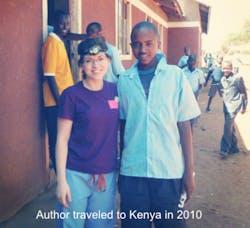By Amber Auger, RDH, MPH
For me, my passion for dental hygiene began in the sixth grade. My science teacher was reviewing the oral cavity, the eruption stages, and the diet and caries process with our class. I was hooked. I decided that moment I would pursue a career in the dental field. Although my original plan of becoming a dentist changed, I have found a fulfilling career in multiple roles.
After graduation, I personally invested in technologies such as sharpen-free instruments, an ergonomically correct saddle stool, and custom loupes that would help preserve my body as I worked chairside.
During the summer of 2009, I traveled to an orphanage in Romania with a small group of my classmates. We stayed at the orphanage for two weeks, hiking to different villages to provide preventive oral hygiene services, nutritional counseling, and fluoride treatments to the community. This was my first time out of the country, and for the first 24 hours I was extremely ill.
Regardless of surviving on Cocoa Puffs—the only item that was not cooked with the water that was making me ill—I was joyful. For the first time, I saw how hygienists can change lives. One week after cleaning a boy’s teeth with aggressive gingivitis, he came running up to me with open arms, hugging me and smiling, revealing healthy gingiva, and saying “no bleed, no bleed!” This was the moment that a fire in me was ignited. I knew I was given these skills to help those without access to care.
I returned from my mission trip, knowing that it would be the first of many. Eight years after the initial trip, I have been to Kenya, the Dominican Republic, and this July I will travel to Nicaragua. The trips have allowed me to learn how to improvise, how to work better under pressure, and remind me that we are made to help one another.
Finding a dental mission organization that sterilizes instruments properly is important. Although some aspect of your working conditions—such as air conditioning, dental chairs, dental lights, and suction are commonly inaccessible—proper sterilization is a must. Search for a group that utilizes the CDC standards to ensure that microbes are destroyed and diseases, such as HIV, are not spread. Per the CDC: “minimum exposure periods for sterilization of wrapped healthcare supplies are 30 minutes at 121oC (250oF) in a gravity displacement sterilizer or 4 minutes at 132oC (270oC) in a prevacuum sterilizer.”1
Passports, visas and updated vaccinations are often required to serve abroad. Additionally, some organizations require participants to collect supplies to utilize abroad. However, most field representatives are happy to donate. Service trips affiliated with dental or dental hygiene schools are often well organized, offer experienced mission-clinicians, and welcome new participants.
Traveling abroad to provide services has allowed me to experience multiple cultures. Witnessing first-hand the benefits of increased fluoride in villages, experiencing the Maasai-Mara tooth brushes made from eucalyptus, and helping to educate the underserved has made me a better clinician. These experiences have allowed me to view oral health in a much more intricate way and has been a defining factor for my employment.
Doctors enjoy having team members that give back to the under- and never-served, and patients love hearing about the trips. In the competitive dental hygiene market, becoming actively involved in public health will increase opportunities both chairside and in academia. The same passion that drove me to serve abroad led me to seek a master’s in public health.
Since obtaining my master’s degree, I have become Chief of Clinical Technology for Jameson, started my own blog, became a KOL for multiple companies, and launched a speaking career. Whether you decide to use your dental hygiene degree as a platform to grow into other roles, or you continue to work chairside full time, do it with passion!
Reference
1.CDC. Guidelines for Disinfection and Sterilization in Healthcare. Available at: https://www.cdc.gov/hicpac/Disinfection_Sterilization/13_0Sterilization.html. Accessed March 13, 2017.








